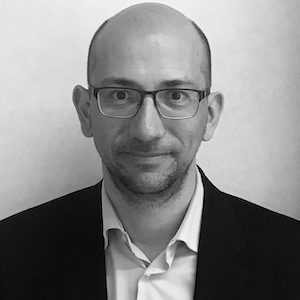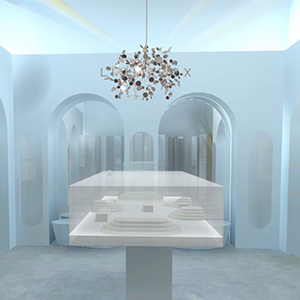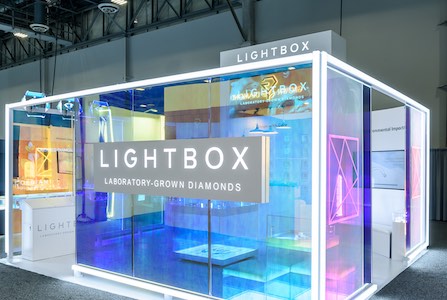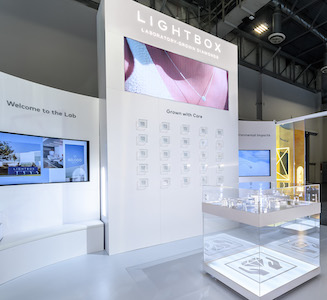
De Beers’ lab-grown diamond brand, Lightbox Jewelry, exhibited at the JCK show in Las Vegas for the first time this year—in, we should note, the lab-grown section. Antoine Borde, the veteran marketer who was appointed Lightbox CEO last November, spoke to us from its candy-colored booth about Lightbox’s retail strategy, if it will ever sell for under $800 a carat, and the possibility of adding engagement rings to its collection.
Lightbox just debuted a “concept store” at House of Showfields in Williamsburg, Brooklyn, which will be open through November. Why that location?
For us, Showfields is a way to connect directly to consumers. We’re a direct-to-consumer brand. We did a few pop-ups when we launched Lightbox.
For six months, [the store gives us] the ability to interact with consumers. Showfields is a great place to do that because they offer us a lot of research capabilities. I want to learn from consumers what’s their perception of Lightbox, what’s the perception on the range of products, and get insights on what the brand could develop in terms of products. The Showfields location in Brooklyn is a way for us to be in an area that is up-and-trending, with a younger demographics, which is in line with our target consumers.

What’s the next step for the brand as far as retail? Do you expect more brick-and-mortar stores?
Today we are present in around 160 doors in the U.S. We will pursue that. We are very selective in the doors we go in. [Having] our own retail space for now is not decided. This will be a good test and a learning experience for us. When it comes to the brand, we need consumers’ wants to be at our core. Consumers now have much more understanding of what lab-grown diamonds are, so they are being more proactive in what they expect in terms of products. Self-gifting is a high-trending area where we need to invest even more. It’s listening to the consumer and making sure we are where we should be. That’s where the marketing background I bring will be an important component.
I notice that some price points at Showfields go as high as $3,700. Lightbox has always said it’s not a luxury brand. For most consumers, $3,700 is serious money.
We have always been very consistent in the way the brand has been positioned, in terms of price, in terms of communications, in terms of products. The range is expanding as the brand is growing. Our portfolio now goes from $250 to $3,700, so the range is quite wide, which allows consumers to find the products that they want. The consumer tends to go more toward higher-carat stones, so that means higher price points. We are expanding in both ways, so we have stud earrings for $3,700 and we just launched new rings for $500. We are expanding on both ends, in order to have a wider range, with wider options for consumers.
As you know, there plenty of direct-to-consumer lab-grown websites. I could probably name seven off the top of my head. How do you stand apart from them?
We have two areas where I think we have a very strong competitive advantage. [First is] the quality of our products—having the right standards and the proper products. The second is around carbon neutrality. This is an important message. The carbon-neutral certification that we just received covers a very wide scope. We know a lot of consumers are very sensitive to that.
Lightbox has done some private-label deals. Do you plan to do more?
We are open to more collaborations. We want to make sure the brands that we collaborate with have the same standards as we have, in terms of positioning, in terms of branding, in terms of carbon neutrality. So this is something we’re still open to with a few brands. We have two brands we’re working with, and we’re very open to continue working with other brands from a white-label perspective.
De Beers is a natural diamond company. Do you think Lightbox will ever be a significant part of its sales?
That is going to be the driven by the market. Lightbox was a very early player in the game. We have set the standard for the industry. We want to continue to set the standard for the industry.
Lightbox is a very important business for De Beers. It’s a different business than the natural business. We see a market that is developing extremely fast. We are following that trend. I don’t know where lab-grown diamond is going to go. I envision the lab-grown diamond industry being more diversified in the nature of the product, in the nature of the shapes we bring, in the nature of the color of stones we bring. There could be much more diversity around that, by using lab-grown diamonds in a different way than they are used today.

Would you do more colors and different kinds of unusual shapes?
Color-wise, I would only do it if we do it in the right way. When you look at our pinks, our blues, they are very natural. If they don’t look natural, I don’t want to do it. They have to look right.
Shapes, I feel there could be high potential. Of course there’s the standard shapes—we are launching ovals, we are launching cushion cuts, we are launching princess cuts, we have a lot of new shapes coming. I would love to have shapes that have never been done before. This is what LGD can allow us to do. You can have bigger stones, and you can shape them in whatever way you want. I really feel there is a massive opportunity to bring this kind of newness, and a more fun kind of modern product.
You are known for your $800-a-carat pricing—do you see that dropping?
Our pricing has been consistent from the start. In the [lab-grown] market, retail prices have been going down. But I’m quite confident that we have been consistent and very logical in the way we communicate, and very transparent around how our products are priced and how our products are grown. That is part of the DNA of the brand, and we want to maintain that. So no further comment than that.
Lightbox makes diamonds in Oregon. Most lab-grown diamond production is moving to India and China. Any chance your company will be moving?
Again, I come back to the carbon neutrality. For us, having 100% renewable green energy that is very stable and high-quality is not something that you find easily outside the U.S. This is something that will remain. We know there is a lot of capacity coming from India. I don’t know what the future holds, but the plan for now is to grow at our Oregon facility.
How many carats are you producing?
Around 200,000 carats a year.
Most of those go to Lightbox?
Yes. We can grow more, because we have the space. So we have the ability to expand.
You don’t sell engagement rings now. Would you in the future?
It’s a matter of listening to the consumer. We have a lot of consumers who ask, “When are you going to sell engagement rings?” By the way, our loose stone business has done very well. It’s possible those stones might be used for something outside of Lightbox. I can’t answer precisely this question, but for now we don’t have [engagement rings] in our range. But that’s a very, very consistent message [we are getting]. We are focused on listening to our consumers, because at the end of the day it’s important to answer to their demands.
[UPDATE: Less than two weeks after this interview, Lightbox began carrying engagement rings on its site.]
How do Lightbox shoppers view natural diamonds?
I don’t have any insight on that. The consumers that come to Lightbox come for our product, they come to Lightbox for our design. They don’t come to Lightbox because they see us as an alternative to natural diamonds.
They are two parallel industries, and two parallel products. I don’t see them as competing. Self-gifting is an example: You can buy certain products for a significant other or a friend or a family member that you wouldn’t buy for yourself.
You can have similar products in the same category, but for different occasions and different purposes. When I was at L’Oréal, we carried several different brands of makeup. We carried $15 mascara, and we had mascara for $80. You wore the $80 mascara when you went out for certain occasions; you use the $15 mascara when you go out every day. You can have a natural diamond and LGDs in your jewelry case, but you would use them for different occasions and different ways.
Does being connected to a natural diamond company like De Beers limit what you can do?
I haven’t seen any limitation so far. I try to bring a lot of new ideas, newness, and a new dynamic to the brand, and I’m being encouraged to do that. [De Beers’] new CEO is very attached to that. He wants Lightbox to continue its trajectory. From the start, the brand has had a very fresh DNA, very modern.
We are part of the De Beers family. Of course De Beers gives us support, but it’s not something that puts any burden on us.

(Photos courtesy of Lightbox Jewelry)
Follow JCK on Twitter: @jckmagazine
Follow JCK on Facebook: @jckmagazine





